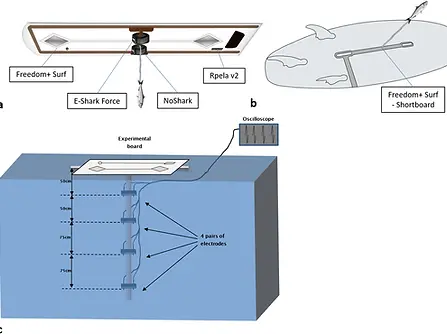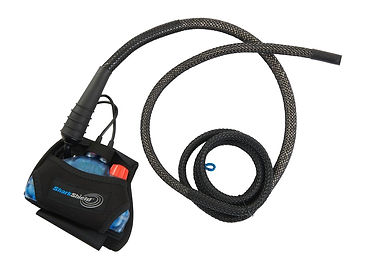SHARK MITIGATION SCIENCE
Accessible Research, Safer Waters

Electric mitigation science
Electric mitigation aims to deter sharks. These come in the form of deterrents, repellents, and a few trials of electric barriers (electric barrier papers can be found on the Barriers and Enclosures page).
Studies that assess electric deterrents/repellents generally can test whether these products can deter sharks (as opposed to testing the ability to detect sharks or test bite resistance, for example). This is because electric mitigation works at a short range (within approximately 3m) and studies can be designed with control trials (e.g., deterrent turned off), which gives researchers the ability to compare the deterrent and control.
While electric mitigation measures generally show a higher level of effectiveness for deterring sharks than other mitigation types, it is important to keep in mind that not all electric deterrents are effective.
The research

Counterillumination is a form of camouflage in which animals produce light to match the brightness of their surrounding environment to hide themselves from predators or prey. This study assesses whether lights attached to the underside of a fake seal reduced the number of times white sharks breached or followed the seal. The study used LED lights underneath the fake seal, which was towed behind a boat. Lights that were brighter than the background environment were the most effective at deterring white sharks.
Ryan, L.A., Gennari, E., Slip, D.J., Collin, S.P., Peddemors, V.M., Huveneers, C., Chapuis, L., Hemmi, J.M. and Hart, N.S., 2024. Counterillumination reduces bites by Great White sharks. Current Biology.

This study assesses the ability of Ocean Guardian’s Freedom+Surf and Freedom7 to deter white sharks, tiger sharks and bull sharks. The Freedom+Surf reduced the likelihood of shark bites by 54% across the three species. The Freedom7 reduced tiger shark bites by 69% but did not have an effect on white sharks. This may have been due to the placement of the electrodes during testing. The deterrents increased the time it took for a shark to bite, and also increased the number of physical reactions and passes for all species.
Clarke, T.M., Barnett, A., Fitzpatrick, R., Ryan, L.A., Hart, N.S., Gauthier, A.R., Scott-Holland, T.B. and Huveneers, C., 2024. Personal electric deterrents can reduce shark bites from the three species responsible for the most fatal interactions. Scientific Reports, 14(1), p.16307.

This study assesses the ability of the BOAT01 (80V and 150V versions) to deter white sharks at a greater distance than other personal deterrents (approx 8m deep x 6m wide). Compared to control trials, fewer baits were taken when the deterrent was switched on, but this was not statistically significant. The 150V version increased the distance that sharks passed (control: 1.59 ± 0.28 m versus 3.33 ± 0.33 m), but not to the manufacturers desired extended distance. Both versions increased the likelihood of sharks experiencing a physical reaction.
Riley, M., Bradshaw, C.J. and Huveneers, C., 2022. Long-range electric deterrents not as effective as personal deterrents for reducing risk of shark bite. ICES Journal of Marine Science, 79(10), pp.2656-2666.

This study assesses whether DC 12 Volts 180 Newtons electromagnets deter bull sharks and if an eco-friendly Exclusion barrier is more effective than the Sharksafe barrier at deterring bull sharks. One-hundred trials showed that electromagnetically treated baits resulted in significantly more avoidance and reduced feeding rates. Twenty-seven, one hour trials showed that the Exclusion barrier region elicited more avoidance rates and less entrance and exit rates compared with the control and Sharksafe barrier.
O’Connell, C.P., Crews, J., King, A. and Gressle, J., 2022. Evaluating the shark deterrent effects of the novel exclusion barrier in comparison to the rigorously tested sharksafe barrier technology. Journal of Marine Science and Engineering, 10(5), p.634.

Effectiveness against white sharks of the rpela personal shark deterrent device designed for surfers
This study assesses the ability of the Rpela V2 to deter white sharks. The device significantly reduced the likelihood of a bite (0.75 to 0.25, a 66% reduction) and an interaction (touch or bite; 0.80 to 0.50, a 38% reduction) compared to control trials. The average distance between the shark and deterrent also increased when the deterrent was switched on.
Blount, C., Pygas, D., Lincoln Smith, M.P., McPhee, D.P., Bignell, C. and Ramsey, O., 2021. Effectiveness against white sharks of the rpela personal shark deterrent device designed for surfers. Journal of Marine Science and Technology, 29(4), p.13.
Five different electric deterrents were tested on bull sharks - the E-Shark Force, NoShark, Rpela v2, Freedom + Surf and Freedom + Surf—Shortboard. Authors compared the number of baits taken, number of passes, number of reactions and the distance between control (devices switched off) and treatment (devices switched on) trials. The Freedom + Surf was the most effective deterrent ( significantly reduced baits taken by 42.3%) followed by the Rpela v2 (16.5%) and Freedom + Surf—Shortboard (16.2%). Distance was not affected by the deterrents. The number of passes and reactions significantly increased during Freedom + Surf trials. Effectiveness reduced over time for all deterrents.

Gauthier, A.R.G., Chateauminois, E., Hoarau, M.G., Gadenne, J., Hoarau, E., Jaquemet, S., Whitmarsh, S.K. and Huveneers, C., 2020. Variable response to electric shark deterrents in bull sharks, Carcharhinus leucas. Scientific Reports, 10(1), p.17869.

This study assesses the ability of the Ocean Guardian Scuba7 to reduce the likelihood of blacktip reef sharks from feeding. The Scuba7 reduced the rate of baits taken by 67%, (100% in control trials versus 33% in treatment trials). Time of take the bait increased during treatment trials (165 ± 20.40 s vs. 38.9 ± 3.35 s). Sharks passed at a greater distance (80.98 ± 1.72 cm vs. 38.88 ± 3.20 cm) and made more passes per trial (19.38 ± 2.29 vs. 3.62 ± 0.53) than when the Scuba7 was switched off.
*This study also assesses a bite-proof fabric. Results are outlined in the Injury Reduction section of this website.
Thiele, M., Mourier, J., Papastamatiou, Y., Ballesta, L., Chateauminois, E. and Huveneers, C., 2020. Response of blacktip reef sharks Carcharhinus melanopterus to shark bite mitigation products. Scientific reports, 10(1), p.3563.
This study assesses whether an electric anklet shark deterrent (Electronic Shark Defense System) can deter white sharks. There was no significant reduction in the proportion of white sharks interacting with the bait. At close range (<15.5 cm) the deterrent significantly reduced the number of baits bitten.
Egeberg, C.A., Kempster, R.M., Hart, N.S., Ryan, L., Chapuis, L., Kerr, C.C., Schmidt, C., Gennari, E., Yopak, K.E. and Collin, S.P., 2019. Not all electric shark deterrents are made equal: Effects of a commercial electric anklet deterrent on white shark behaviour. PLoS one, 14(3), p.e0212851.


Five different deterrents were tested on white sharks - the Shark Shield Pty Ltd [Ocean Guardian] Freedom+ Surf (electric), Rpela (electric), SharkBanz bracelet (magnetic), SharkBanz surf leash (magnetic), and Chillax Wax (smell-based). Authors compared the number of baits taken, number of passes, number of reactions and the distance between control (devices switched off) and treatment (devices switched on) trials. The Freedom + Surf was the most effective deterrent, reducing the proportion of baits taken from 96% (control) to 40% (device switched on), and increasing the pass distance from 1.6 ± 0.1 m (control board) to 2.6 ± 0.1 m (device switched on). No other deterrents had a measurable affect on white shark behaviour.
Huveneers, C., Whitmarsh, S., Thiele, M., Meyer, L., Fox, A. and Bradshaw, C.J., 2018. Effectiveness of five personal shark-bite deterrents for surfers. PeerJ, 6, p.e5554.
How close is too close? The effect of a non-lethal electric shark deterrent on white shark behaviour
This study tests the ability of the Shark Shield Freedom7™ to deter white sharks. On their first pass, sharks were deterred at an average distance of 131 (± 10.3) cm. Distance decreased with each pass, but the deterrent remained effective at deterring sharks. No evidence was found that the device attracts sharks.

Kempster, R.M., Egeberg, C.A., Hart, N.S., Ryan, L., Chapuis, L., Kerr, C.C., Schmidt, C., Huveneers, C., Gennari, E., Yopak, K.E. and Meeuwig, J.J., 2016. How close is too close? The effect of a non-lethal electric shark deterrent on white shark behaviour. PLoS One, 11(7), p.e0157717.

This study tested the ability of the Shark Shield Freedom7™ to deter white sharks from a stationary bait, and when a decoy was being towed. The proportion of stationary baits taken was not affected by the deterrent. However, the amount of time before taking the bait was increased, the number of passes increased and there were fewer interactions within 2m when the deterrent was switched on. Authors believe that the distance between the bait and electrodes may have affected whether the sharks took the bait (e.g., if the bait were close to the electrodes, fewer baits may have been taken). Fewer breaches and surface interactions occurred when the deterrent was switched on during tow experiments (no breaches and only two surface interactions versus 16 breaches and 27 surface interactions when switched off).
Huveneers, C., Rogers, P.J., Semmens, J.M., Beckmann, C., Kock, A.A., Page, B. and Goldsworthy, S.D., 2013. Effects of an electric field on white sharks: in situ testing of an electric deterrent. PloS one, 8(5), p.e62730.
Different voltage gradients were tested on scalloped hammerhead (Sphyrna lewini) and leopard sharks (Triakis semifasciata) in combination with a food scent. Shimmy, head twitch and retreat behaviours were seen in both species when swimming at a close distance to the electric fields. Both species remained significantly further away when the electric field was switched on. Hammerhead sharks retreated at significantly stronger field strengths than leopard sharks, which suggests that behavioural responses to electric fields may differ between shark species.
Marcotte, M.M. and Lowe, C.G., 2008. Behavioral responses of two species of sharks to pulsed, direct current electrical fields: testing a potential shark deterrent. Marine Technology Society Journal, 42(2), pp.53-61.



This study assesses the ability of the SharkPOD to deter white sharks. During 5-minute trials, the probability of a bite was 0.70 when switched off, compared with 0.08 when switched on. During 10-minute trials, the probability of a bite was 0.90 compared with 0.16 when switched on.
Smit, C.E. and Peddemors, V., 2003. Estimating the probability of a shark attack when using an electric repellent: applications. South African Statistical Journal, 37(1), pp.59-78.